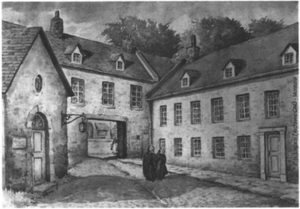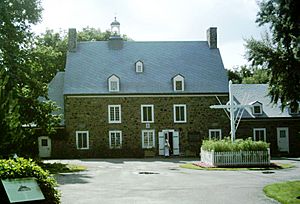Congregation of Notre Dame of Montreal facts for kids
The Congrégation de Notre Dame (CND) is a group of religious women called sisters. It was started in 1658 in Ville Marie, which is now Montreal, Canada. This group was founded by Marguerite Bourgeoys. She was asked to come from France to create a special religious community in Ville Marie.
Marguerite Bourgeoys created a new kind of religious group for women. Unlike many other groups, her sisters did not have to stay inside a convent. They were allowed to live and work outside. The CND played a very important part in the early days of New France. They helped women and girls in the colony and gave them important roles.
The CND also started a boarding school for girls. They looked after the filles du roi, who were young women whose trip to the colony was paid for by the King. The King wanted to help families grow in New France. Some of these filles du roi and the sisters also worked as missionaries with First Nations people. The main home of the CND has been in Montreal for over 350 years. Marguerite Bourgeoys became a saint in 1982 and is Canada's first woman saint.
Contents
How the CND Began
The Congrégation Notre-Dame was a religious group for women that started in France. It was founded by Pierre Fourier and Alix Le Clerc. This group was focused on education. Marguerite Bourgeoys joined a part of this group in Troyes, France, around 1640.
Marguerite Bourgeoys had a special idea for a new kind of religious community. She wanted women to be active and help people outside the convent. She based her idea on another group called the Canonesses of Mattaincourt.
In 1653, Paul de Chomedey de Maisonneuve, who founded Ville Marie (Montreal), visited Troyes. He invited Marguerite Bourgeoys to come to Ville Marie to teach. She sailed from France in June of that year. When she arrived, she spent her time helping others in many ways. She opened her first school in April 1657. Soon after, she went back to France to find helpers. Four women joined her and came back to New France.
Where the CND Was Located
By 1665, the CND group included Marguerite Bourgeoys and three other sisters living in Montreal. They taught in a stone building known as the "stable school," which opened in 1658. The convent was near the corner of Notre-Dame and Saint Paul Street in what is now Old Montreal.
The early convent was a private place, away from the busy public life of Montreal. It was set back on its own land. The Hôtel Dieu and surrounding walls helped keep it separate. This gave the sisters privacy and safety, even though they were near merchants, soldiers, and workers in the colony.
Maison Saint-Gabriel Farm
In October 1662, Maisonneuve gave land in Pointe-Saint-Charles to Marguerite Bourgeoys. This was to start a farm that would feed the sisters and support their work. In 1668, Bourgeoys bought the nearby Maison Saint-Gabriel farm. The sisters of the CND ran this farm for almost 300 years. It was also a temporary home for some of the filles du roi, or King's Daughters. On the farm, the sisters grew food and made products to help the CND, new settlers, and others in need.
Today, the Maison Saint-Gabriel is a museum. It shows what farming and life were like in the 17th and 18th centuries. The property, buildings, and grounds have been restored. The museum has about 15,000 items that help recreate the feeling of the old house.
The CND was officially recognized by King Louis XIV in 1671. The Catholic Church gave it official status in 1698. This was 40 years after it started and two years before Marguerite Bourgeoys passed away.
In 1675, Bourgeoys built a chapel dedicated to Notre Dame de Bon Secours. To make sure her group had more freedom, Bourgeoys created a community where members were not cloistered. They took simple vows. They usually taught children and helped priests in different areas where CND convents were set up.
Even though François de Laval, the Bishop of Quebec, approved the community, Bourgeoys wanted to make sure their non-cloistered way of life was part of their rules. She traveled to Europe a third time to talk with the bishop, who was in France. After returning, she resisted many attempts to combine her new group with the cloistered Ursulines. She wanted to keep the CND's original way of life.
New CND houses were opened in places like Pointe-aux-Trembles, Lachine, Champlain, and Château Richer. In 1685, a mission was started at Sainte Famille on the Island of Orléans.
Changes to the CND Rules
Later, new rules were put in place for the nuns. They had to take vows, including one that meant they could not leave the convent whenever they wanted. These rules also created a difference between sisters who had taken their vows and those who had not. The bishop also required new members to pay a dowry. This made it harder for women from poorer families to join.
Even with these more traditional rules, the CND sisters kept some of their earlier practices. Many continued to teach, travel, and share their knowledge with other areas across New France.
CND Sisters and Education
Schools in New France were mostly run by the church. Teaching Christian values was seen as the most important part of education. Children in religious schools learned Christian moral principles. The goal of formal education in the 1700s was to create a polite and Christian population. Almost all teachers in New France were part of the clergy. A rule from 1727 stated that all teachers needed approval from the Bishop of Quebec. Priests closely watched what teachers taught and how they taught it.
In the colony of Île Royale, there was no formal education system when it was founded in 1713. Île Royale included French-controlled parts of Nova Scotia and Prince Edward Island. In 1713, when the colony was being set up, no one talked about building schools. They thought missionaries would open parish schools. By the mid-1720s, there were still no schools, but over 300 children.
Local officials wanted to start a public Catholic school in Louisbourg, but royal officials disagreed. So, local officials asked the CND in Montreal for help. They suggested sending sisters to teach girls. In 1727, Marguerite Roy and two other sisters were sent from Montreal. Soon after arriving, they opened a school and began teaching 22 girls. The bishops of Quebec, especially Bishop Saint-Vallier, were very concerned about the moral education of girls in the colony.
However, the sisters faced money problems. They needed to buy a house to teach in. They even sold straw mats to soldiers to earn extra money. Religious brothers, who were much wealthier, had more resources and better buildings for their teaching. Île Royale was a poor religious community. Low income, debt, and budget problems were constant issues for the CND sisters until 1753.
Despite limiting the number of girls they accepted, many girls in Île Royale were successfully taught by the CND sisters. As was common at the time, teaching good morals and Christian values was more important than teaching reading and writing. Both girls who attended daily and those who boarded at the school benefited. Along with religious duties, religious texts helped girls learn to read and write. Some math was also taught, though it was limited. The education given to girls by the CND sisters in Île Royale was considered good for that time. Students at the school followed a regular weekly schedule.
In the late 1800s, the CND opened missions in different areas of Quebec, Ontario, Nova Scotia, New Brunswick, Prince Edward Island, and the United States. Many academies and schools were also opened in Montreal.
The CND Today
In 1908, the Notre-Dame Congregation founded Notre Dame Ladies College, which is now known as Marianopolis College.
In 1926, Waterbury Catholic High School, a girls' high school in Waterbury, Connecticut, was founded. In 1975, it joined with Holy Cross High School (Connecticut). As of 2018, ten sisters from the CND still worked in the Waterbury area. They served in churches, schools, a prison, and a hospital.
In 1981, a CND community was started in Troyes, France, where Marguerite Bourgeoys was born. Another community was formed in France in 1989 in Estissac. There, the sisters created the Marguerite Bourgeoys Cultural Centre.
As of 2020, there were about 860 members in the CND. Their main home is still in Montreal.
In 2023, the CND announced that the land where the Villa Maria high school is located would be sold. This makes the school's future uncertain. The current lease ends in 2030, and the CND plans to sell the land the year after. The CND said that the number of nuns is decreasing, which is one reason for their decision to sell. The money from the sale would be used to help poor students in public elementary and high schools in Quebec. In 2024, Marianopolis College bought the property at 4873 Westmount Avenue, which is its Westmount Campus, from the CND. In the same year, the Sisters also sold their building at 4120 Vendôme Avenue to the Selwyn House School.
See also
- Peter Fourier
- Maison Saint-Gabriel
- François de Laval
- Jean-Baptiste de La Croix de Chevrières de Saint-Vallier




